Archived Mold Remediation Blog Posts
Hidden Killers: Mold and its dangers in Northbrook, Wheeling, and Glencoe.
7/30/2018 (Permalink)
Mold is one of the headaches that comes with owning a house. It is common, not always visible and can be very difficult to get rid of. Bathrooms, kitchens, laundry rooms, basements, and crawlspaces are all common places where mold can take root and it can be very expensive to clean up, not to mention hazardous to your health. Unexplained illnesses can be linked to undiscovered mold problems and make air toxic if untreated which in turn, in extreme cases, can lead to death. There are however ways of attempting to prevent the growth of mold and to clean it up when it has already established itself.
Moisture is the primary contributor to the growth of mold, which is why bathrooms, kitchens and basements are highly susceptible to it. One way of preventing the growth of mold is to ensure that moisture does not get trapped anywhere. In the bathroom, make sure that the ceiling fan is working and keep it running after you shower, also ventilation can help. If you can keep the area dry, then it is unlikely to become infested. Similarly, if you investigate under sinks and other areas where water is common and make sure that no moisture is getting trapped, that should help prevent mold. Cleaning out gutters, having de-humidifiers and making sure to keep an eye on common problem spots for mold will help to prevent its growth and any health consequences. However, being vigilant does not always stop mold from taking root.
Leaky pipes in walls, malfunctioning de-humidifiers, or floods can cause mold without the homeowner realizing. If you suspect that you might have a mold problem (smell is a great indicator of this) but you are not able to find where it is coming from, there are mold testing kits. It can be professionally done for a cost or you can buy a kit for as little as $10. These kits, however, are not considered to be very reliable, so be wary if you choose to use them.
Once you have identified a mold problem there are ways of treating it. If the mold is well contained in a space of less then 10 feet, then you may be able to clean it on your own using 1 part bleach to 15 parts water. Make sure to use goggles and gloves if you attempt to clean the mold on your own. Also make sure that there is good ventilation and that you are careful because bleach can be dangerous. You can gently scrub the mold away, but do not dry the wall. Drywall is porous so the bleach will need to soak into the wall in order to really get to the mold, but this also poses another problem with cleaning it yourself. Mold visible on a porous material like drywall can obscure a larger problem beneath the surface which will be far more difficult to clean. But sometimes bleach is not enough. If the area affected is large, or mold has formed in carpets and ventilation systems, you will need to remove all carpeting and clean out air ducts with caution. It is important to wear a facemask so that you do not breath in any spores. Moreover, you will need to cover unaffected parts of your house in plastic sheets, otherwise spores might spread during the removal and breed in new parts of the house, exacerbating the issue. Cleaning heavily infested spaces can be very dangerous and difficult, especially if you happen to have black mold. You’ll need to identify where the mold resides and how to remove it. This includes floors, drywall, and insulation. We highly suggest hiring professionals in these extreme cases. If you need assistance with the headaches of mold, call the professionals of SERVPRO of Northbrook, Wheeling, and Glencoe!
Moldy clothes, we have an answer!
5/16/2018 (Permalink)
The reason clothing is so susceptible to mold growth is not just because of the mold-inviting circumstances within the laundry room. Generally, when it is worn, clothing collects sweat and skin cells, as well as dirt and other forms of moisture and organic material that mold loves to feast on. Then, it is placed in the laundry hamper and usually sits for days before it it is finally washed. This scenario is typical and may not result in a noticeable mold infestation, but should the soiled laundry be allowed to fester long enough, a mildew smell may be present, as well as visible signs of green, blue, gray, black, or sometimes even white mold on clothes.
Another scenario is becoming more common due to busy lifestyles and poor habits. The quick development of mold on clothes after washing may be surprising to some, but it is quite an ordinary occurrence for those with overwhelmed schedules or those who are vulnerable to procrastination because they often forget to remove clothing from the washing machine once the cycle is finished. As time passes, this leads to the rapid proliferation of mildew and mold on clothes after washing, due to the remaining moisture. Neglecting to put the wet clothes in the dryer for a few hours is not what makes mold grow. Neglecting the clothes in the washer for 6 hours or longer–sometimes a day or even a few days–is the problem. Before too long, a mildew smell will be detected in the washer and clothing. Some assume this is the residue of soap, and while that may be true to some extent, the fact of the matter is that most soaps contains lard and other organic (even synthetic) materials that mold can thrive off of. The smell is not necessarily the residue of soap, but an indication that mold is producing a secondary metabolite–the mildew smell–from consuming that soap.
What is a natural detergent to kill mold? Here is what you will need.
- Two 5 oz. organic castile soap bars (naturally-scented with lavender or peppermint is great but non-scented works just the same)
- 3 cups of washing soda (no, it’s not the same as baking soda)
- 2 cups of borax
- 30 drops of certified-pure lavender essential oil (optional but highly advisable for a mold killing laundry detergent)
Once you have all the materials, this is what to do.
- Cut the castile soap bars into small pieces or chunks. (This is crucial to avoid damaging the food processor.)
- Place the cut castile soap pieces or chunks in the food processor bowl. Pulse the soap on high until what remains are large crumbs.
- Add the washing soda to the food processor and pulse for 1 minute. (After pulsing, all the ingredients should be in powder form and well-combined. If not, try running the food processor again and then mixing with a spoon.)
- Empty the washing soda and castile soap into the storage container. Add the borax and blend well with a spoon.
- Add the essential oils of choice (optional but beneficial) and be sure to mix well.
Do not place this mixture into the drawer or dispenser, place it directly in with the laundry.
Understanding your coverage for Mold in IL
5/9/2018 (Permalink)
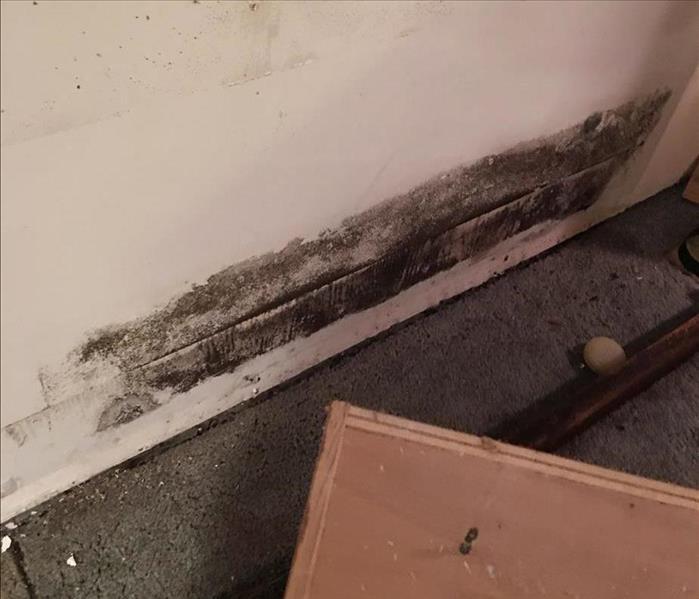 Mold growing behind a bookcase.
Mold growing behind a bookcase.
Before purchasing a homeowners insurance policy, you might want to read it thoroughly. Most insurance policies do not cover mold, but why?
General maintenance is a big issue when discussing mold coverage. In the eyes of the insurance company, small leaks and keeping the humidity down can prevent many mold scenarios. It is the responsibility of the homeowner to make these repairs, to avoid any mold growth and prevent claims.
Floods are typically not covered by your homeowners policy as well, and generally speaking, if the water is not cleaned up in a timely manner, mold can develop, which can worsen the issue. Unless you have additional coverage for flooding, you are responsible for the repairs.
Accidental water losses are typically covered by your policy, however, if left untreated, mold can develop which can cause issues with your claim. It is crucial that you respond to accidental water damages quickly, to avoid having the mold discussion with your insurance company.
If you have any questions about mold and the process of treating it, give the professionals at SERVPRO of Northbrook/Wheeling/Glencoe a call day or night at (847)498-8889.
Important steps to follow when you discover mold in your home
4/25/2018 (Permalink)
If you see visible mold, do not disturb it. You can inadvertently spread the mold infestation
throughout your home. When mold is disturbed, the mold can release microscopic mold spores
which become airborne and can circulate inside your home.
What to Do:
-Stay out of affected areas.
- Turn off the HVAC system and fans.
- Contact SERVPRO of Northbrook/Wheeling/Glencoe for mold remediation services.
What Not to Do:
- Don’t touch or disturb the mold.
- Don’t blow air across any surfaces with visible or suspected mold growth.
- Don’t attempt to dry the area yourself.
- Don’t spray bleach or other disinfectants on the mold.
About Our Mold Remediation Services
SERVPRO of Northbrook/Wheeling/Glencoe specializes in mold cleanup and restoration, in
fact, it’s a cornerstone of our business. Our crews are highly trained restoration professionals
that use specialized equipment and techniques to properly remediate your mold problem quickly
and safely.
If You See Signs of Mold, Call Us Today – 847-498- 8889
The right way to clean mold
4/13/2018 (Permalink)
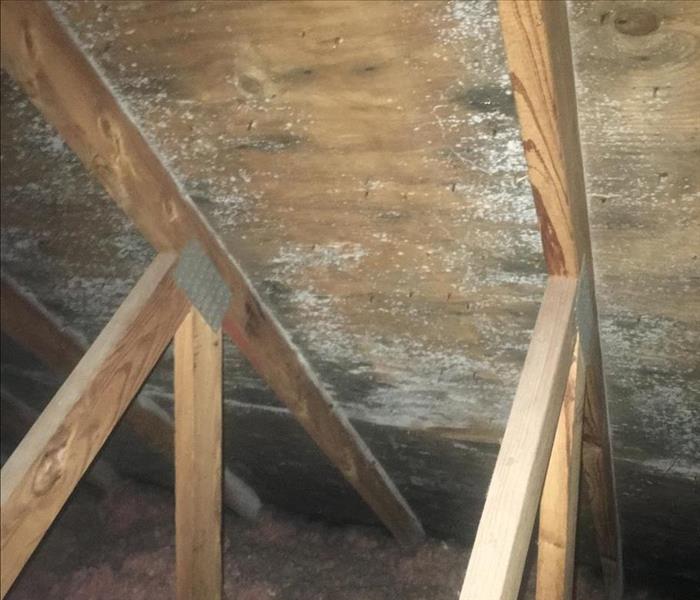 Mold found in an attic.
Mold found in an attic.
Have you ever heard of anyone say that they always have mold, they just spray some bleach on it and it is gone! Well, that's not the case. Bleach does kill mold, but does not kill the spores that are produced from the mold itself. So, bleach can be a quick fix, but it does not solve the issue.
First thing that needs to be done, is find out why it is growing. Is there a source of water that you may not know about, which is feeding the growth? Or is it that you have a damp, humid basement? Whatever the reason, its there, and the issue needs to be solved prior to remediation, or it will just come back.
Once the source has been discovered, now its time to do work! Before we even touch mold, we have to contain the affected area. Once mold has been touched or disturbed, it can become airborne and stick to other parts of the room, some which may be unaffected. Once we contain the area and set up our proper protective equipment, negative air will be run from the contained area with an air scrubber. This draws air from the surrounding environment, places it through a HEPA filter, and blows out clean air.
The next step is either cleaning, or removing the affected materials. When we clean items that have been exposed to mold, we must use a HEPA vacuum to remove any surface mold, or spores that the vacuum can pick up. Once every square inch of the contained area has been HEPA vacuumed, its time to apply an antimicrobial agent to the contained area as well. Every square inch must be cleaned!
On some more severe cases, you might need to fog the affected area or seal materials such as studs or sheathing, which does not need to be removed.
Mold Tips: Do's and Don'ts
3/22/2018 (Permalink)
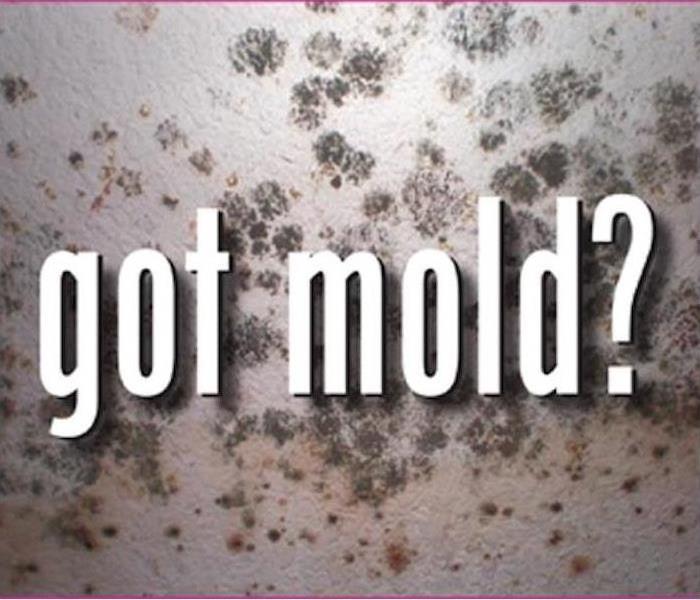 Got Mold?
Got Mold?
MOLD!!!!
The four letter word that all homeowners, tenants, property managers, real estate agents and insurance professionals hate to hear! Mold can be a rather difficult at times, and can have negative health effects on children, elderly, people with weakened immune systems, and those with severe allergies. If not handled properly, it can become airborne and spread everywhere! So what are some of the best practices while trying to remove mold?
Do:
1. Call a professional! All of our SERVPRO technicians are highly trained in dealing with mold and have years of experience!
2. Try to contain the mold- Keep the mold from spreading to other rooms by keeping the door closed to that room. You can also use painters tape to seal the room at the doorway. You may not know when you are spreading it around, so it is best to leave it alone, until a professional can examine it.
3. Wear proper protective equipment when dealing with mold- When dealing with mold, you should always wear equipment to protect yourself. You may not be able to see mold spores attach themselves to your clothing!
4. Try to discover the source of water. Mold (just like any other living organism) needs food, air, and water. The only thing we can really control is the moisture in the environment. So where is the moisture coming from?
Don'ts:
1. DONT IGNORE IT! Mold will not go away on its own, it will burrow into a porous material and live for a very long time. SERVPRO professionals use specialized HEPA vacuums and a special antimicrobial agent to remove and kill mold, and mold spores.
2. Don't use Bleach! Bleach is not a good way to kill mold. It is a temporary fix, but will not solve the underlying problem.
3. Put any sort of air movement on the area of concern. This can actually spread the mold to other areas, and can contaminate areas that were not previously affected.
4. Don't stress about it! We have seen it all, and can help you with any mold problem you may be experiencing! Give us a call anytime at (847)498-8889.
Black Mold, What is It?
9/25/2017 (Permalink)
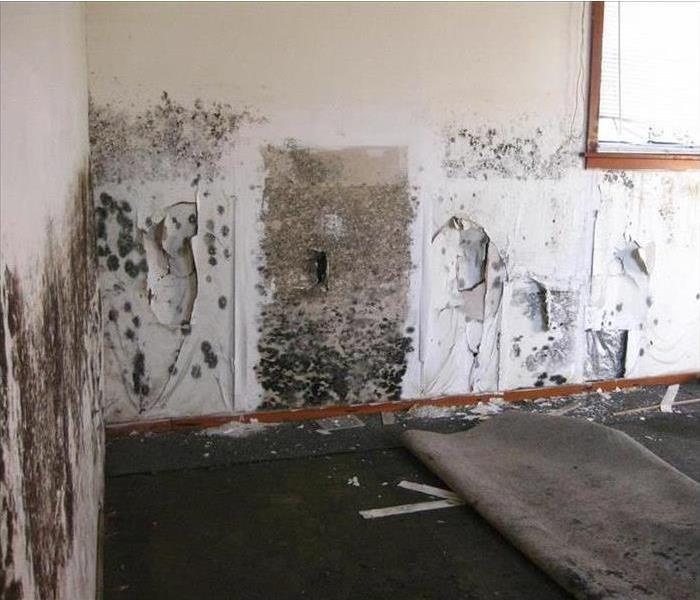 This picture depicts the damages mold can have on any room!
This picture depicts the damages mold can have on any room!
Stachybotrys chartarum is the type of mold often called “black mold” or “toxic mold”. Sensational news reports warn about the dangers of black mold and these stories can be alarming and confusing. Any mold in your home should be treated with caution – stay out of affected areas and don’t touch or disturb the mold.
Please refer to our Mold Damage Tips to learn more about mold and what to do until help.
How Do I Tell If It’s Black Mold?
Since many types of mold can produce allergens and irritants, you should contact a qualified mold remediation company regardless of the color or type of mold. In many instances, multiple types of mold can exist in the same house or structure. If you suspect that you have a mold problem, contact a SERVPRO Franchise Professional immediately.
If You See Signs of Mold, Call Us Today (847)498-8889
Understanding Mold
When water intrudes into your property, mold growth can start in as little as 48 hours. Consider the following mold facts:
- Mold is present almost everywhere, indoors and outdoors.
- Mold spores are microscopic, float along in the air, and may enter your home through windows, doors, or AC/heating systems or even hitch a ride indoors on your clothing or a pet.
- Mold spores thrive on moisture. Mold spores can quickly grow into colonies when exposed to water. These colonies may produce toxins harmful to humans and pets.
- Before mold remediation can begin, any sources of water or moisture must be addressed. Otherwise the mold may return.
- Mold often produces a strong, musty odor, and that odor can lead you to possible mold problem areas.
- Even higher-than-normal indoor humidity can support mold growth. Keep indoor humidity below 45 percent
Northbrook/Wheeling/Glencoe Residents: Follow These Mold Safety Tips If You Suspect Mold
5/18/2017 (Permalink)
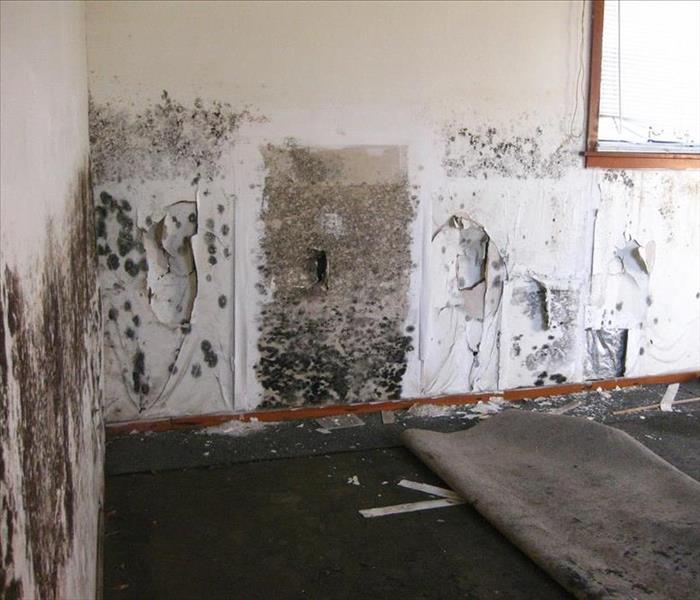 Be careful! Without proper training, you could be spreading mold throughout
your home.
Be careful! Without proper training, you could be spreading mold throughout
your home.
If you see visible mold, do not disturb it. You can inadvertently spread the mold infestation
throughout your home. When mold is disturbed, the mold can release microscopic mold spores
which become airborne and can circulate inside your home.
What to Do:
? Stay out of affected areas.
? Turn off the HVAC system and fans.
? Contact SERVPRO of Northbrook/Wheeling/Glencoe for mold remediation services.
What Not to Do:
? Don’t touch or disturb the mold.
? Don’t blow air across any surfaces with visible or suspected mold growth.
? Don’t attempt to dry the area yourself.
? Don’t spray bleach or other disinfectants on the mold.
About Our Mold Remediation Services
SERVPRO of Northbrook/Wheeling/Glencoe specializes in mold cleanup and restoration, in
fact, it’s a cornerstone of our business. Our crews are highly trained restoration professionals
that use specialized equipment and techniques to properly remediate your mold problem quickly
and safely.
If You See Signs of Mold, Call Us Today – 847-498- 8889





 24/7 Emergency Service
24/7 Emergency Service


